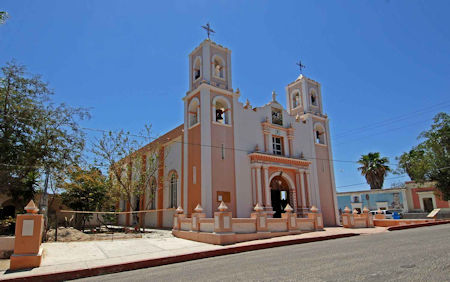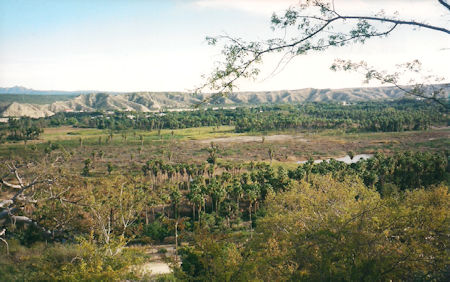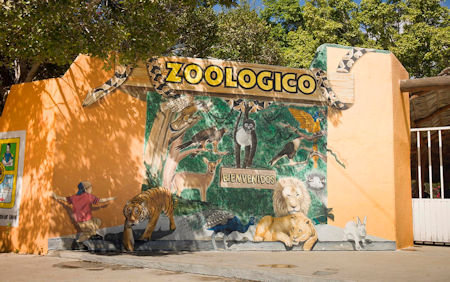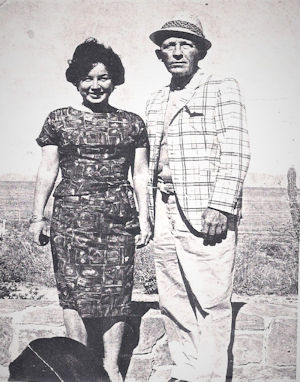 |  |
By Greg Niemann

One of the most restful villages on the Baja California peninsula wasn’t always that way. A mission established in 1724 in the verdant valley of Santiago (about 25 miles north of the Los Cabos Airport) had to be abandoned years later because of rebellions.
Jesuit missionary Ignacio Maria Napoli first visited the area in 1721 and baptized a few Indians. He returned in 1724 and founded the Misión Santiago de los Coras (later called Santiago el Apóstal).
While Indians north of Loreto were more passive and yielded to the ways of the padres, many of those to the south did not. Especially resentful were the Pericú witch doctors who had lost their stature and continued to resist.
A decade after the mission was founded, a rebellion broke out over the entire south cape region, killing the padres at San Josẻ del Cabo and Santiago.
The heart of the 1734 rebellion was at Santiago, where a group of Pericues first killed two unarmed Spanish soldiers and then Padre Lorenzo Carranco. They dragged the padre outside his home where they ended his life with arrows, sticks, and stones. They also killed a mission Indian who tried to help Carranco. After throwing the bodies into a bonfire, they ransacked the homes and church and set fire to both.
Then they went to San Jose del Cabo where they found Padre Nicolas Tamaral and killed him in the same brutal manner. The uprising finally ended after two years as the main groups of dissident Indians were confronted by soldiers and passive mission Indians.

Years later, after both La Paz to the north and San Jose del Cabo to the south gained importance, Santiago, which straddles the Tropic of Cancer, settled into a restful existence. Author Ross Browne noted in his 1868 journey: “Santiago occupies two sites, each on a picturesque eminence. On one of these stands the old Mission, still in a good state of preservation. The sugar crop in the valley gave promise of an abundant supply of cane.”
Santiago changed very little
In the following century Santiago changed very little. It was reputed to be “One of the most attractive towns in the peninsula,” according to 1970’s Lower California Guidebook by Gerhard and Gulick.
The town is built on two lomas (hills) with a valley in between. Enough water to irrigate about 1,500 acres comes from several springs. Between the two hills and the west side of the valley is a former lake, which was drained and planted with sugar cane.
The 1971 Sunset Magazine Guide to Baja California says: “Santiago doesn’t advertise its attractions, and the casual visitor is likely to miss them. The irrigated valleys around the town are green in the early spring with sugar cane and fruit trees. An old huge trapiche (wooden sugar mill) crushes the cane and makes it into panocha (brown-sugar cones) loved all over Mexico.”
The entire Santiago area has about 4,000 residents, mostly involved in agriculture today. Former BCS Governor Leonel Cota Montaño is from Santiago and while in office (1999-2005) the town enjoyed a general sprucing up, including a new plaza and a reinforced concrete access road.
If you arrive in July you will find the residents in a festive mode. They celebrate the Feast of St. James (Santiago) on July 25 and there is a fiesta complete with music, dancing, food, and a parade.
A neat little zoo

Loma Norte is reached first, 1.7 miles from Highway 1, and contains the town’s plaza, the town hall, a Pemex station, and a few stores. Loma Sur has a brick church on the old mission site, government offices, more homes, and a neat little zoo. Just keep driving through town and you’ll find the Parque Zoológico at the end of the paved road. While it’s no San Diego Zoo, it is the only zoo in Baja California Sur and is a delightful surprise.
When I first visited it in 1998 with my fishing buddy Don Lund, we were both amazed at the scope of the zoo, the only one south of Mexicali. In addition to native indigenous animals, including rattlesnakes in a well-constructed pit, there were bears, monkeys, wolves, foxes, ostriches, tigers, and much more. Outside groups rallied to ensure that the animals were being kept in a desirable habitat and some changes and improvements had been made. The Parque Zoológico is open daily, 6 a.m. to 4 p.m., and is free. There is a receptacle for donations.
Waterfalls and Hot Springs
The zoo is not the only surprise in the Santiago area. Nearby are the Santa Rita hot springs at Agua Caliente and the 40-foot Sol de Maya waterfalls dropping into a beautiful inviting pool that begs visitors to dive in. The waterfalls in the Cañon de la Zorra (Canyon of the Fox) can be reached a few miles north on a dirt road and then a short hike. Today it is a protected area on private property (Rancho Ecológico), and accessible to the public for a small fee.
The hot springs are reached a bit farther south in another canyon tumbling out of the Sierra La Laguna, the highest mountain range in BCS. I’ve noticed that these days various types of excursions (ATVs, Vans, etc.) go into the area from the Cabo-based hotels. You can drive on your own or hook up with a tour group.
A 53 Year Landmark

The neatest surprise for me in Santiago is in the heart of the wide, fertile valley between the two lomas. There, on the palm-covered lane among date palms, mangoes, sugar cane, papayas and bananas, is the El Palomar Hotel/Restaurant.
Until the El Palomar Hotel was opened in 1965 by Cirilo and Virginia Gómez, visitors to Santiago were put up for the night at the town hall. The El Palomar has long welcomed travelers and offers rooms and meals. It is really more of a bed and breakfast, with only eight inexpensive rooms facing a fragrant garden. Through the years they have offered guides, horses, and dove-hunting arrangements.
Cirilo Gómez had previously worked at the nearby Rancho Buena Vista, the east cape area’s first hotel. On the advice of a famous Buena Vista guest, who suggested that the Santiago area inland would be ideal for a hunting lodge, Cirilo and Virginia established the El Palomar. That famous guest was the very popular American crooner Bing Crosby!
The El Palomar sustained considerable damage during a 1976 hurricane, but it was rebuilt and reopened in 1981 by the Gómez son, Sergio Gómez and his wife Gloria. Sergio one time proudly showed me a photo of his mother with Bing Crosby, and gave me a newsprint copy.
On a 2001 visit, Sergio mentioned that a recent visitor was the singer Barbra Streisand. After they prepared her a meal of fresh fish mojo de ajo style, she told Sergio it was unbelievably good and gushed over the new “favorite restaurant” of hers.
On that earlier visit in 1998, we arrived in Santiago at the Loma Norte town plaza and took that left road down into the riverbed where on the valley floor the El Palomar is nestled among the trees on the left. We enjoyed a wonderful lunch in their shaded patio overlooking all sorts of citrus and other fruit trees.
Before we left, another couple arrived. After they ordered lunch, they couldn’t resist wandering the garden and touching the huge grapefruit, lemons, and bananas. They were from the East Coast and unfamiliar with citrus on trees, which we kind of figured out. But where they were from didn’t make any difference. The lush tropical trees and plants surrounding the El Palomar can even impress a lot of jaded Californians, including the famous Bing Crosby.
About Greg
Greg Niemann, a long-time Baja writer, is the author of Baja Fever, Baja Legends, Palm Springs Legends, Las Vegas Legends, and Big Brown: The Untold Story of UPS. Visit www.gregniemann.com.

Bajabound Insurance is the only company we use for our vehicles when we go to Mexico. They have...

Convenient, great website, prices are reasonable.

Wonderful customer service, they made it easy to get my motorcycle insured for a last minute trip...